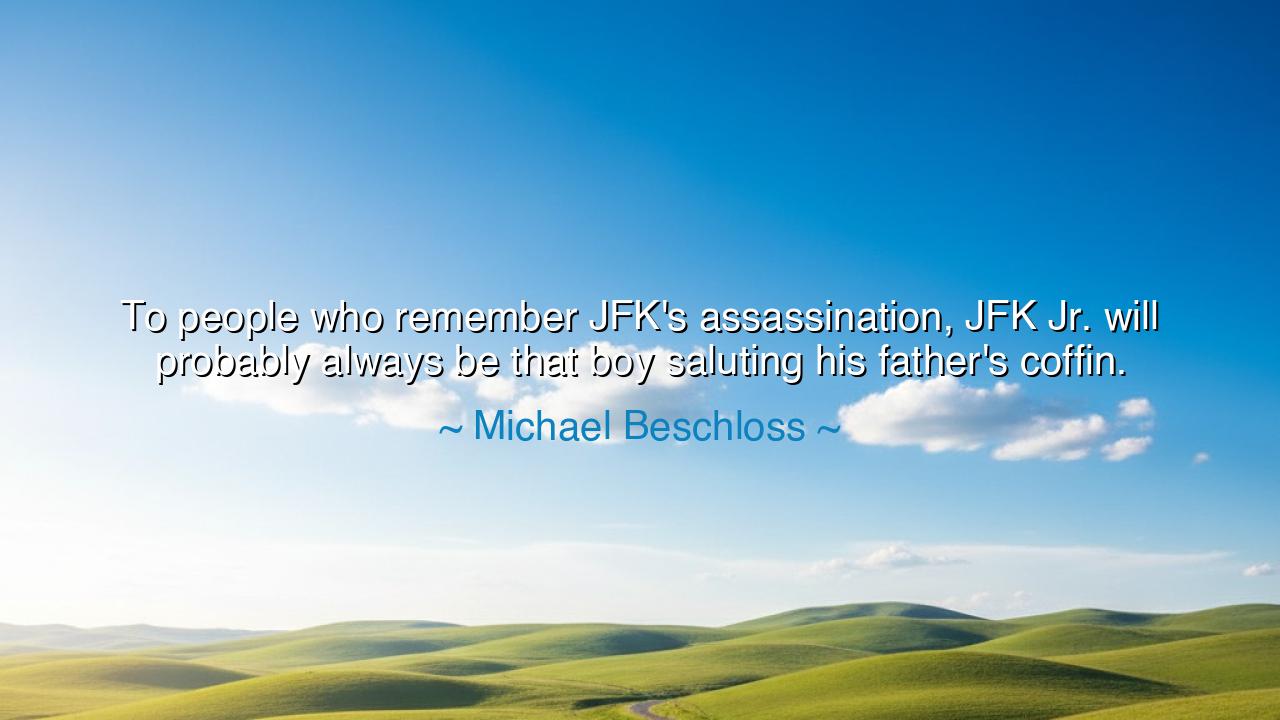
To people who remember JFK's assassination, JFK Jr. will probably
To people who remember JFK's assassination, JFK Jr. will probably always be that boy saluting his father's coffin.






“To people who remember JFK's assassination, JFK Jr. will probably always be that boy saluting his father's coffin.” Thus spoke Michael Beschloss, the historian and chronicler of presidents, whose words capture not merely an image, but a wound in the heart of a nation. In this quiet, almost mournful sentence, he reveals the strange alchemy of memory — how certain moments become frozen in time, how the image of innocence can haunt the conscience of generations. For in that small boy’s solemn salute, on that gray November day in 1963, the people of America saw not only grief, but the end of a dream.
The origin of this quote lies in the collective remembrance of President John F. Kennedy’s funeral, held three days after his assassination. The world watched as the nation mourned, but one image transcended all others: the President’s young son, John F. Kennedy Jr., just three years old, standing beside his mother as the casket passed, raising his hand in salute to the father he would never know. That gesture — innocent, untrained, but heartbreakingly dignified — became one of the defining images of the century. It symbolized the collision of innocence and tragedy, of promise cut short, of the torch of youth standing before the mystery of death.
Beschloss’s words remind us that history is not only written in documents and speeches, but in images that pierce the soul. To those who lived through that era, the picture of young John Jr. saluting is inseparable from the memory of his father’s death. In that single gesture, the nation’s grief was embodied; in that child’s face, America saw its own lost innocence. The historian understood that for those who remember, JFK Jr. would forever remain that small boy — not the grown man who later sought his own path, not the publisher or public figure he became, but the eternal child of tragedy, preserved in the amber of memory.
There is in this truth a kind of melancholy wisdom: that history, for all its movement, is often shaped by stillness — by the moments that never pass. Just as the ancient Greeks immortalized Achilles in the instant of his rage, or as the world remembers Anne Frank forever as the girl in hiding, so too does America remember John Jr. as the boy who saluted. The human heart, overwhelmed by loss, seeks symbols to hold its pain. And so it was that this image became not merely a photograph, but a myth, a vision of grief that transcends words and endures through time.
But Beschloss’s quote also carries a deeper meditation on how memory freezes people in form. The child who saluted became, in the public mind, a perpetual emblem — unchanging, innocent, and bound forever to the tragedy that birthed the image. When John F. Kennedy Jr. himself died decades later, in 1999, in the crash of his plane off the coast of Martha’s Vineyard, the nation’s sorrow rekindled that old memory. It was as if the boy in the blue coat had never grown, as if time itself had circled back upon the pain of the past. The historian’s words remind us that for those who remember, some moments never fade — they are etched not on paper, but upon the soul.
From this story we may learn much about how the heart remembers. History is written with ink, but remembrance is written with love and loss. The images we carry of others — a gesture, a smile, a glance — often define them more than years of living. In this way, the past continues to live through symbols, and the people within it remain both real and unreal, both human and eternal. As we recall John Jr.’s salute, we are not only remembering a boy, but the fall of an age — the passing of the bright optimism that once believed the future could be made perfect.
So, my children, take from this teaching a lesson about both memory and mercy. Do not let the images of the past imprison the living. Remember with reverence, but also with compassion for the complexity of those who live beyond their symbols. Every person, even one enshrined in tragedy, is more than a single moment. Just as John Jr. grew beyond the child we saw, so must we grow beyond the limits of nostalgia. To honor history truly is not to keep it frozen, but to allow it to breathe — to understand, to forgive, to learn.
And thus, the wisdom of Beschloss endures: that the power of memory lies not only in what it recalls, but in how it shapes our vision of humanity. Let us remember that small boy’s salute, yes — but let us also remember what it meant: that grief can unite a people, that innocence can dignify sorrow, and that even in the shadow of death, the gesture of the living can remind the world of its own fragile beauty.






AAdministratorAdministrator
Welcome, honored guests. Please leave a comment, we will respond soon